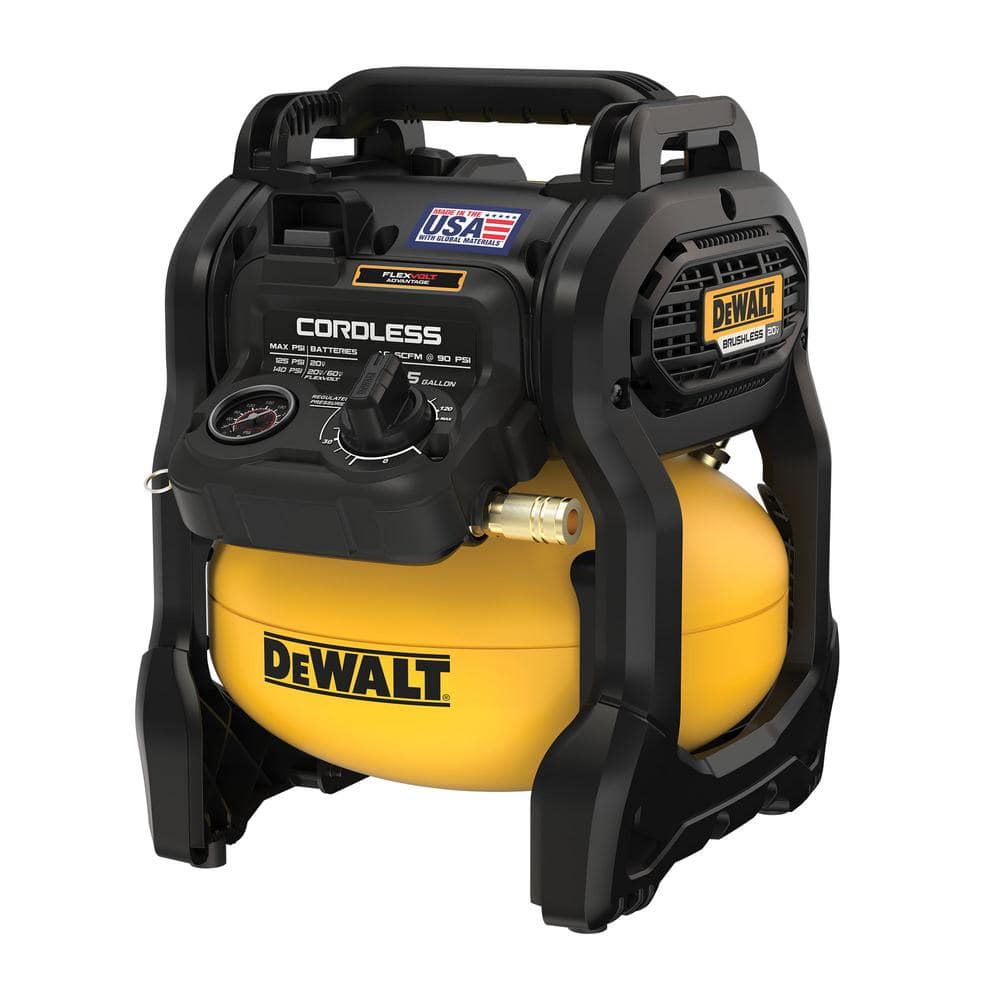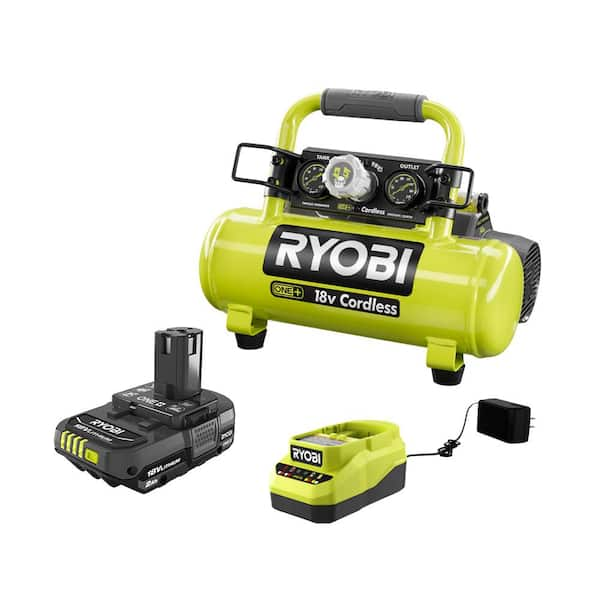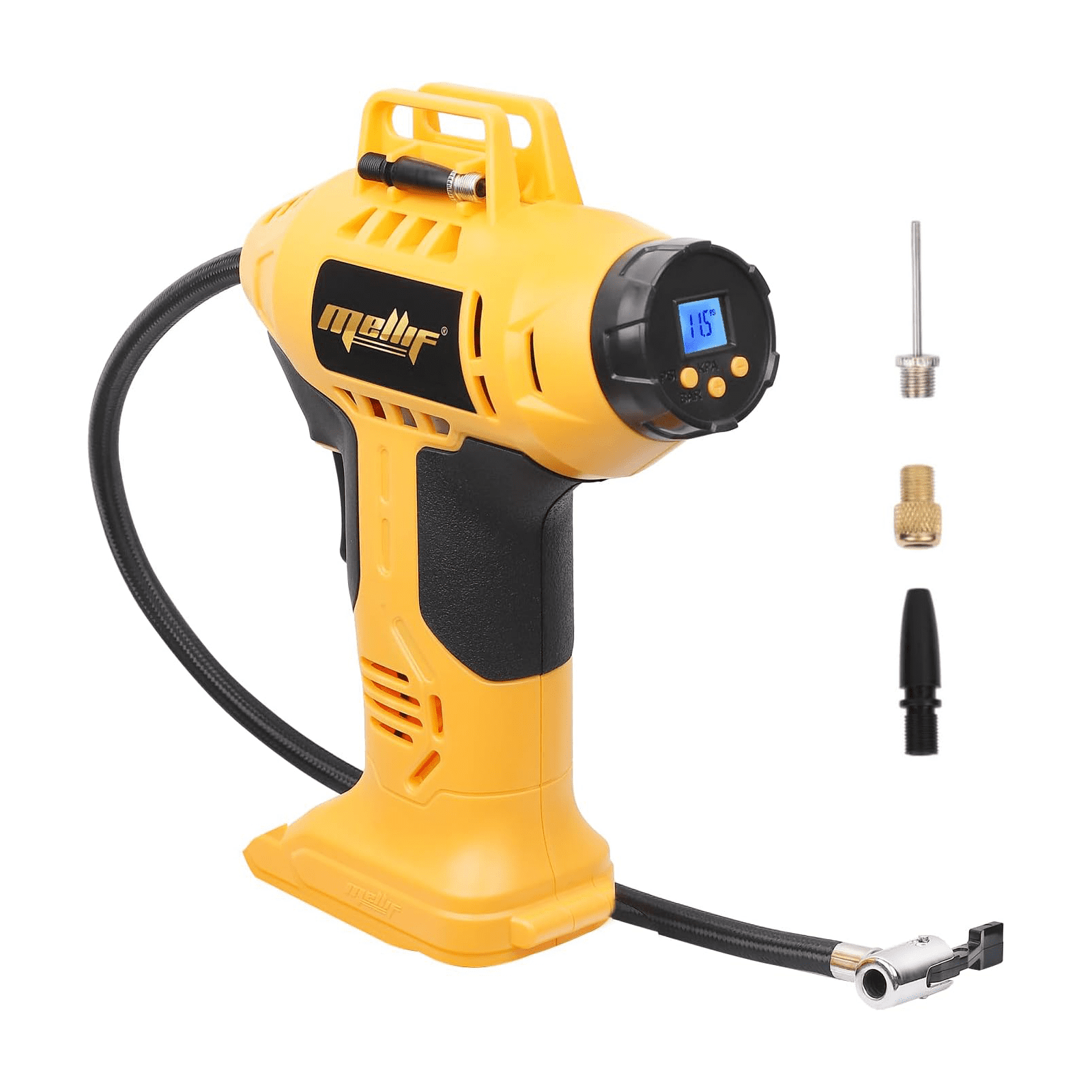A battery powers an air compressor, supplying energy for operation. These devices are essential for various tasks, from inflating tires to powering tools.
Air compressors have become indispensable in many industries and households. They convert power into potential energy stored in compressed air, providing versatile applications. Whether it’s inflating sports equipment or powering pneumatic tools, these machines streamline tasks efficiently. Battery-operated models offer portability and convenience, allowing users to work in remote locations without a power source.
Understanding how batteries and air compressors work together enhances their effectiveness. With advancements in technology, modern air compressors are more efficient and easier to use. Choosing the right combination can significantly improve productivity in both professional and personal projects.

Credit: www.homedepot.com
The Evolution Of Power Tools
Power tools have transformed the way we work. They make tasks faster and easier. From early manual tools to advanced electric devices, innovation has driven this change. Battery technology and air compressors are key players in this evolution.
From Manual To Electric
Manual tools required strength and time. The shift to electric tools changed everything. Electric tools allow for:
- Faster operation
- Less physical effort
- Increased precision
Electric power tools became popular in the 20th century. They powered drills, saws, and other essential tools. This shift improved productivity in various fields.
Innovations In Battery Technology
Battery technology has come a long way. Early batteries were heavy and short-lived. Modern batteries are lighter and more powerful. Key advancements include:
| Battery Type | Advantages | Common Uses |
|---|---|---|
| Nickel-Cadmium (NiCd) | Durable, good for high-drain devices | Power tools, emergency lights |
| Nickel-Metal Hydride (NiMH) | Higher capacity, eco-friendly | Digital cameras, hybrid vehicles |
| Lithium-Ion (Li-ion) | Lightweight, long-lasting | Smartphones, laptops, modern power tools |
Li-ion batteries are now the standard for power tools. They charge quickly and last longer. This technology has made tools more efficient.
Battery Basics
Understanding battery basics is crucial for using tools effectively. Batteries power many tools, including air compressors. Knowing how they work can improve your experience.
Types Of Batteries Used In Tools
Different types of batteries serve various tools. Here are the most common types:
- Nickel-Cadmium (NiCd) – Durable and affordable.
- Nickel-Metal Hydride (NiMH) – Higher capacity than NiCd.
- Lithium-Ion (Li-ion) – Lightweight and long-lasting.
Each type has its benefits and drawbacks. Choose based on your needs.
Understanding Capacity And Voltage
Capacity and voltage are key battery features. Capacity measures how much energy a battery can store. Voltage indicates the power level a battery provides.
| Feature | Definition |
|---|---|
| Capacity | Measured in amp-hours (Ah), shows energy storage. |
| Voltage | Measured in volts (V), shows power output. |
Higher capacity means longer run time. Higher voltage delivers more power.
Choosing The Right Battery For Your Tool
Finding the perfect battery for your tool is essential. The right battery boosts performance and longevity. It ensures your tool operates efficiently. A compatible battery saves time and money. Here’s how to choose wisely.
Compatibility And Performance
Battery compatibility impacts your tool’s efficiency. Using the wrong battery can damage your tool. Always check the manufacturer’s specifications.
- Voltage: Ensure the battery voltage matches your tool.
- Capacity: Higher capacity means longer runtime.
- Type: Lithium-ion batteries are popular for their lightweight and efficiency.
Here’s a simple table for quick reference:
| Battery Type | Voltage Range | Typical Use |
|---|---|---|
| Lithium-ion | 12V – 18V | Power tools, cordless devices |
| Nickel-Cadmium | 7.2V – 18V | Older power tools |
| Lead Acid | 12V – 48V | Heavy-duty applications |
Longevity And Maintenance Tips
Taking care of your battery extends its life. Follow these tips for better longevity:
- Charge Regularly: Avoid letting the battery fully discharge.
- Keep it Cool: Store in a cool, dry place.
- Avoid Overcharging: Use chargers designed for your battery type.
- Clean Contacts: Keep battery terminals free from dirt and corrosion.
By following these steps, your battery will serve you well. Proper care enhances performance and reliability.
The Mechanics Of Air Compressors
Understanding the mechanics of air compressors can enhance your projects. These machines convert power into potential energy. This energy is stored in compressed air. Let’s explore how they work and their different types.
How Air Compressors Work
Air compressors operate using a simple principle. They draw in air and compress it. This process increases the air’s pressure and energy. Here’s a step-by-step explanation:
- Intake: Air enters the compressor through an inlet valve.
- Compression: A piston or rotary element compresses the air.
- Storage: The compressed air is stored in a tank.
- Release: When needed, air is released through an outlet valve.
This cycle repeats, providing a constant source of compressed air. The pressure level depends on the compressor type and design.
Types Of Air Compressors
There are several types of air compressors. Each type serves different needs. Here’s a breakdown:
| Type | Description | Common Uses |
|---|---|---|
| Reciprocating Compressors | Use pistons to compress air. | Automotive repair, home use. |
| Rotary Screw Compressors | Utilize two rotating screws to compress air. | Industrial applications, continuous use. |
| Scroll Compressors | Use two spiral elements to compress air. | Air conditioning, refrigeration. |
| Centrifugal Compressors | Use a rotating disk to compress air. | Large industrial applications. |
Choosing the right type depends on your project needs. Consider factors like pressure requirements and intended use.
Selecting An Air Compressor
Choosing the right air compressor is essential for efficiency. The right model enhances performance and meets your specific needs. Consider various factors for optimal selection.
Factors To Consider
Several key factors influence your air compressor choice:
- Type of Work: Different tasks require different compressors.
- Portability: Consider if you need a stationary or portable model.
- Noise Level: Some compressors operate quietly, while others are loud.
- Maintenance Needs: Some models require more upkeep than others.
Size And Power Requirements
Understanding size and power needs is crucial. Choose a compressor that meets your project demands. Here are some aspects to consider:
| Task | Recommended Size | Power (HP) |
|---|---|---|
| Tire Inflation | Small | 0.5 – 1 HP |
| Nail Gun | Medium | 1 – 2 HP |
| Painting | Large | 2 – 5 HP |
Keep these points in mind:
- PSI Rating: Higher PSI means more pressure for tools.
- CFM Rating: Higher CFM supports more demanding tools.
- Tank Size: Larger tanks hold more air for longer use.
Safety Measures For Using Power Tools
Using power tools like battery-operated tools and air compressors can be dangerous. Proper safety measures protect you from accidents. Following best practices and wearing personal protective equipment (PPE) is essential.
Best Practices
Follow these best practices for safe tool use:
- Read the user manual before operating any tool.
- Inspect tools before use. Check for damage or wear.
- Keep your workspace clean and organized.
- Ensure good lighting in your work area.
- Use tools for their intended purpose only.
Personal Protective Equipment
Wearing the right personal protective equipment is crucial. Here are essential items:
| Equipment | Purpose |
|---|---|
| Safety Goggles | Protects eyes from debris and dust. |
| Hearing Protection | Reduces noise from power tools. |
| Gloves | Protects hands from cuts and abrasions. |
| Dust Masks | Prevents inhalation of harmful dust particles. |
| Steel-Toed Boots | Protects feet from heavy falling objects. |
Using the right gear reduces injury risk. Always prioritize safety. Stay alert and focused while working with power tools.
Maintenance And Care
Proper maintenance is crucial for the longevity of your batteries and air compressors. Regular care ensures efficiency and reliability. Here are essential tips to keep your devices in top shape.
Extending The Life Of Batteries
To maximize the lifespan of your batteries, follow these simple steps:
- Charge Regularly: Keep batteries charged to avoid deep discharges.
- Avoid Extreme Temperatures: Store batteries in a cool, dry place.
- Clean Terminals: Remove corrosion from battery terminals.
- Use Smart Chargers: Opt for chargers with built-in protection.
- Monitor Battery Health: Check voltage regularly for optimal performance.
Air Compressor Upkeep
Taking care of your air compressor ensures it works effectively. Here are key maintenance tips:
| Task | Frequency |
|---|---|
| Check Oil Levels | Every 10 hours of use |
| Drain Moisture | After each use |
| Inspect Hoses | Monthly |
| Change Air Filter | Every 3-6 months |
| Check Belt Tension | Monthly |
Follow these tips for your air compressor:
- Keep it Clean: Remove dust and debris regularly.
- Check for Leaks: Inspect for air leaks frequently.
- Lubricate Moving Parts: Use recommended oil for lubrication.
- Store Properly: Keep in a dry and safe location.

Credit: www.homedepot.com
Future Trends In Power Tools
The power tools industry is evolving rapidly. Innovations in battery and air compressor technology are driving this change. New features enhance efficiency and user experience. Let’s explore the exciting trends shaping the future.
Advancements On The Horizon
Several advancements are on the way for power tools:
- Smart Technology Integration: Tools will connect to smartphones. Users can monitor performance and maintenance needs.
- Improved Battery Life: New battery technologies will last longer. Lithium-silicon batteries promise higher energy density.
- Faster Charging: Ultra-fast charging options will reduce downtime. Users can quickly recharge their tools.
- Compact Design: New tools will become lighter and more portable. This enhances maneuverability in tight spaces.
The Role Of Sustainable Power Solutions
Sustainability is becoming crucial in power tools:
- Eco-Friendly Batteries: Manufacturers are focusing on recyclable materials.
- Energy-Efficient Compressors: New designs will consume less power.
- Solar-Powered Tools: Solar energy will power more tools. This will reduce reliance on traditional energy sources.
Adopting sustainable practices is essential. It benefits both the environment and users. Lower operating costs can be expected.
| Trend | Description |
|---|---|
| Smart Technology | Connects tools to devices for performance tracking. |
| Battery Improvements | Longer-lasting and more powerful battery options. |
| Compact Design | Lighter tools for better handling and storage. |
| Sustainability | Focus on eco-friendly materials and energy sources. |

Credit: www.walmart.com
Frequently Asked Questions
What Is A Battery Air Compressor?
A battery air compressor is a portable device powered by rechargeable batteries. It offers convenience for inflating tires or powering pneumatic tools without needing an electrical outlet. Ideal for outdoor activities, it combines mobility with performance. Users appreciate its versatility and ease of use in various situations.
How Long Does A Battery Air Compressor Last?
The battery life of a battery air compressor varies by model. Typically, you can expect 30 to 60 minutes of continuous use. Factors like battery capacity, load, and settings influence duration. Regular maintenance and proper charging can help extend battery life, ensuring reliable performance over time.
Can I Use A Battery Air Compressor For Car Tires?
Yes, a battery air compressor is suitable for inflating car tires. Many models come with pressure gauges and adapters for various valve types. Ensure the compressor has adequate PSI ratings for your tires. This convenience makes it an essential tool for on-the-go tire maintenance and emergencies.
How Do I Maintain My Battery Air Compressor?
To maintain your battery air compressor, keep it clean and dry. Check the battery regularly for corrosion or damage. Store it in a cool, dry place when not in use. Regularly inspect hoses and connections to prevent leaks and ensure optimal performance during use.
Conclusion
Understanding the synergy between batteries and air compressors enhances their efficiency and performance. Choosing the right battery can significantly extend the lifespan of your air compressor. By investing in quality components, you ensure reliability and effectiveness in your projects. Embrace the right tools to power your tasks and achieve optimal results.

